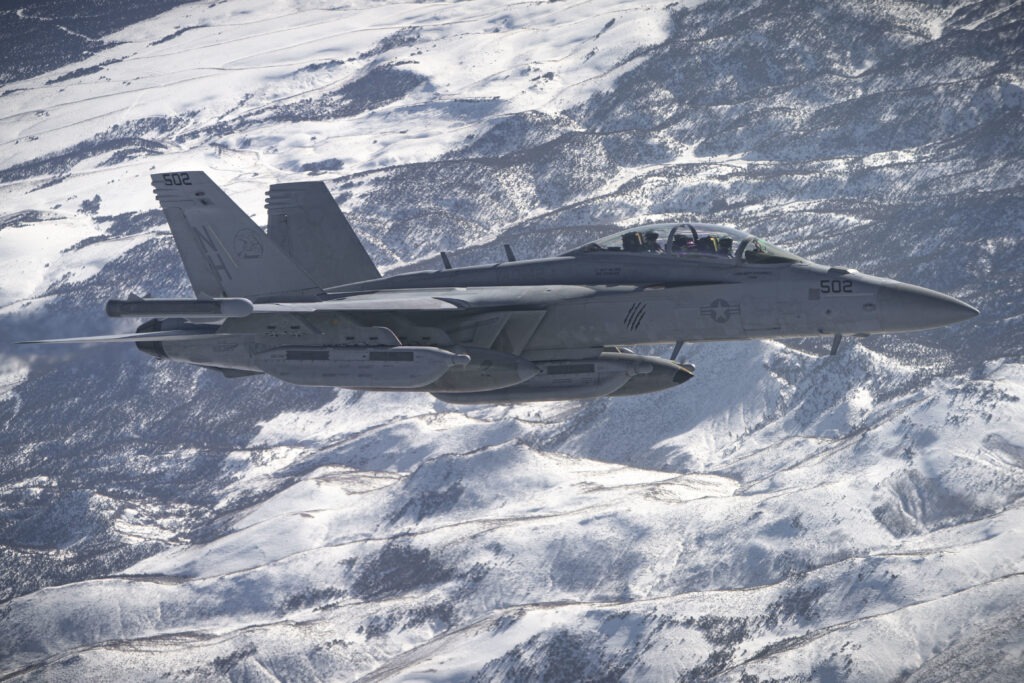
ARLINGTON, Va. — Congress rejected the U.S. Navy’s 2023 budget proposal to deactivate five electronic attack squadrons (VAQs) that operate the Boeing EA-18G Growler electronic attack jet in the defense policy bill recently signed into law by President Joe Biden. Instead, Congress directed the Defense Department to submit a plan to meet the joint airborne attack requirements.
In its 2023 budget submission, the Navy proposed to deactivate its entire expeditionary VAQ force, which deploys to overseas bases in order to provide electronic attack capabilities to the joint force. The five expeditionary VAQ squadrons are separate from the Navy’s VAQ squadrons that deploy aboard aircraft carriers.
The five squadrons originally slated for cut included a total of 25 EA-18Gs, which would have been placed in storage at the Aerospace Maintenance and Regeneration Group at Davis-Monthan Air Force Base in Tucson, Arizona. The cuts also would have freed up approximately 1,020 officers and enlisted personnel. The Navy estimated the savings over the Future Years Defense Plan would be $807.8 million.
In the James M. Inhofe National Defense Authorization Act for Fiscal Year 2023, Congress directed the Navy to retain all 160 EA-1G aircraft and required the following:
A report outlining a strategy and execution plan for the Navy and Air Force to continuously and effectively meet airborne electronic attack training and combat requirements of the joint force, to include establishment or continuation of one or more land-based, joint service electronic attack squadrons and integration of both active and reserve components of both services.
The Navy is the only provider of expeditionary electronic attack jets to the joint force. The Air Force retired its last EF-111A Raven jets in 1998, and the Marine Corps retired its last EA-6B Prowler tactical jets in 2019. The expeditionary VAQ squadrons have deployed to Southwest Asia, Japan, and Italy over the years in support of U.S. and coalition forces. Last year, one squadron – VAQ-134 – was deployed to the European Command as part of the build-up of forces in support NATO’s eastern flank after the Russian invasion of Ukraine.
The expeditionary VAQ squadrons are considered high-demand/high-value assets by the Joint Chiefs of Staff.
The Navy’s five expeditionary VAQ squadrons are all based at Naval Air Station Whidbey Island, Washington: VAQs 131, 132, 134, 135, and 138. The Navy’s only reserve VAQ squadron, VAQ-209, has also been used in an expeditionary role.
The carrier-deployable VAQ squadrons are VAQs 130, 133, 136, 137, 139, 140, 141, 142, and VAQ-144, the latter established in October 2022. All are based at Whidbey Island, except for VAQ-141, which is based at Marine Corps Air Station Iwakuni, Japan, as part of the forward-deployed Carrier Air Wing Five for the USS Ronald Reagan.
- BlueHalo to Test C-UAS System on Marine Corps JLTV - April 29, 2024
- USS George Washington Deploys to U.S. Southern Command, Eventually Headed to Japan - April 26, 2024
- SECNAV Advocates Increased Legal Immigration to Increase Shipbuilder Workforce - April 23, 2024



